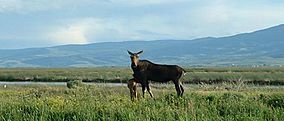Bear Lake National Wildlife Refuge facts for kids
Quick facts for kids Bear Lake National Wildlife Refuge |
|
|---|---|
|
IUCN Category IV (Habitat/Species Management Area)
|
|

A moose and her young in Bear Lake National Wildlife Refuge. USFWS photo.
|
|
| Location | Bear Lake County, Idaho, United States |
| Nearest city | Montpelier, Idaho |
| Area | 19,000 acres (77 km2) |
| Established | 1968 |
| Governing body | U.S. Fish and Wildlife Service |
| Website | Bear Lake National Wildlife Refuge |
The Bear Lake National Wildlife Refuge is a special place in southeast Idaho. It is about 7 miles (11 km) south of Montpelier. This refuge is surrounded by mountains in the Bear Lake Valley. Its elevation ranges from 5,925 feet (1,806 meters) in the marsh areas to 6,800 feet (2,073 meters) on the rocky slopes of Merkley Mountain. The main office for the refuge is in Montpelier.
This amazing refuge covers 19,000 acres (7,689 hectares). Most of it is a bulrush marsh with open water. You can also find flooded meadows here. These meadows are full of sedges, rushes, and grasses. Some parts of the refuge have grasslands and slopes covered in bushes.
The Bear Lake Refuge includes an area known as Dingle Swamp or Dingle Marsh. Long ago, this marsh and Bear Lake were part of a much bigger ancient lake. As the water drained away, Dingle Marsh became smaller. It went from 25,000 acres (10,117 hectares) to less than 17,000 acres (6,880 hectares) before it became part of the refuge.
Animals of Bear Lake Refuge
Many different animals call Bear Lake National Wildlife Refuge home. It's a great place for wildlife to live and grow.
Birds You Might See
During the summer, many birds come to the refuge. You can often spot:
- White-faced ibis
- Sandhill cranes
- Swans
- Ducks
- Geese
- Shorebirds
Mammals Living Here
The refuge is also home to several mammals. Keep an eye out for:
- Moose, especially a mother moose with her young.
- Mule deer during the winter months.
- Smaller animals like muskrats.
- Skunks.
- Cottontail rabbits.
These animals rely on the refuge's different habitats for food, shelter, and raising their families.


